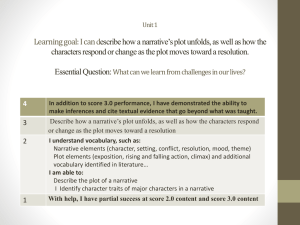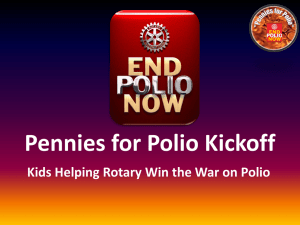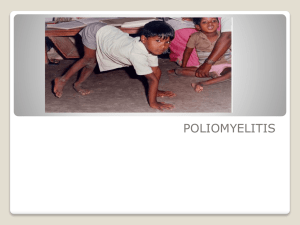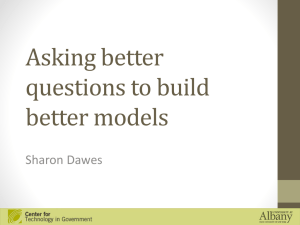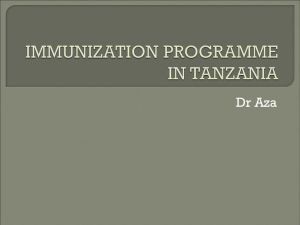CommunicationsSocMob..
advertisement
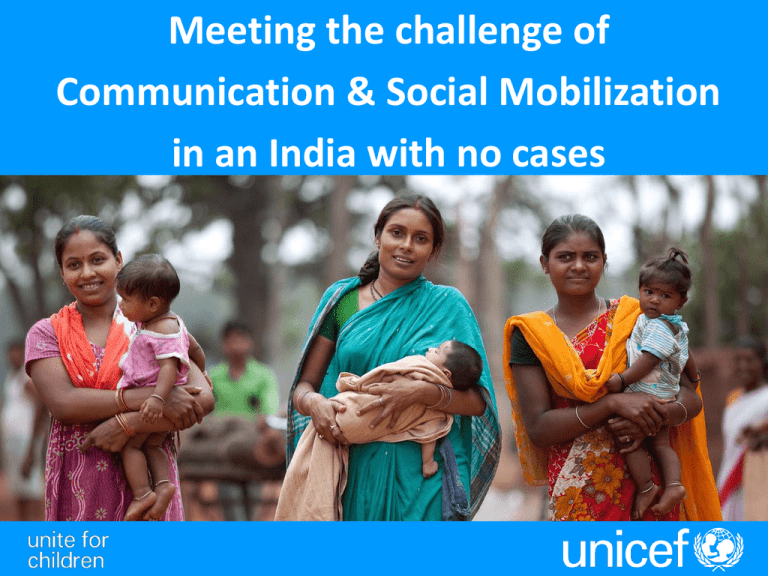
Meeting the challenge of Communication & Social Mobilization in an India with no cases Structure of the presentation • • • • • Social Mobilization Network and Communication Guarding against complacency in an India without cases Media & Advocacy Emergency Preparedness Questions for the IEAG The impact of the Social Mobilization Network UNICEF HR SUPPORT IN POLIO HIGH RISK AREAS, UTTAR PRADESH, 2011 UNICEF CMC – 4931 CORE – 1319 *Data as on 1st Feb 2012 Source: Form A SMNet strength in Kosi & Bihar, 2012 Source: PDSCL % Female 44% 24% 591 (246) 2010 (616) 2011 Rest of Bihar Kosi 390 391 827 628 526 236 264 165 87 252 2007 500 2008 917 2009 1018 2010 1418 2011 High levels of knowledge and trust for OPV Strong acceptance of need to immunize against polio Average OPV doses through RI & SIA to infants, 41 HR blocks, CMC areas Doses A child at one year of age has an average of 10 OPV doses in SMNet blocks of Bihar Age (Months) Source: CMC Fieldbook Guarding against complacency in an India with no cases Respondents believe that Polio can affect children in their household Trust is not as strong for Routine Immunization in the general population Communication materials promoting routine immunization RI Handbill distributed to parents by polio teams to remind them of RI days and schedule RI poster: “Lay the Foundation for a healthy future today. Protect your child against six life-threatening diseases with timely Routine Immunization vaccination and polio immunization in every round.” Bottlenecks in Monitored RI sessions, 41 HR Blocks Bihar Mar-Dec 2011 Sessions = Monitored 429 445 N=6095 485 642 714 639 637 673 671 760 Source: RI Monitoring: SM net Need to sustain MOMENTUM. Need to sustain IMMUNITY. Indian parents and caregivers need to understand that they must protect their child against a disease that is no longer a direct threat, and against all other five vaccine-preventable diseases. There is a significant opportunity to use the momentum and trust generated in the SMNet to promote routine immunization, which acts as our best buffer to ensure high levels of immunity, in addition to other convergence activities. Routine Immunization improves in areas with SMNet Target (80%) DPT coverage in Infants: Jan to Dec 2011 Bihar HR Blocks Vs. Non HR Block 41 HR Block Yearly Target <1 Ch= 256836 Monthly Target <1 Ch= 21403 Non HR Block Yearly Target <1 Ch= 1272500 Monthly Target <1 Ch= 106042 Source: Block Coverage GoB • • • • THE SOCIAL MOBILIZATION OPPORTUNITY Children from 80% of refusal families in Howrah remain unvaccinated in RI 9% of children in Howrah are fully immunized 18% of children are delivered at an institutional facility. Exclusive Breastfeeding rates are low ACTION (IF SUPPLY LINES ARE HEALTHY): LARGE-SCALE RI COMMUNICATIONS CAMPAIGN – media buys, communication campaigns and sustained community mobilization, awareness and advocacy — that can transition into broader areas of child survival and development SMNet convergence for other child survival interventions West Bengal Families reached with convergent activities in West Bengal, Oct 11 - Jan 12 123189 97058 79458 71865 67070 65363 Nov 11 57707 Dec 11 46553 47262 43532 Jan 12 36010 24472 25661 29439 9255 HandWashing Oct 11 Toilet Use Breast Feeding Routine Immunisation IPC Learning Needs Strategy • Communication Training • Five convergence areas • Underserved Strategies Training • Data-based planning Training on interventions • Training of trainers • Sub-Regional Training Coordinators • BMC level • Management training • Supervisory level of staff Focus on supporting training for Front-Line Workers Continuous risk assessment for communication 107 block-level profiles reviewed monthly Media Tonality Monitoring reports State Polio Convergence Taskforce Meetings State Polio Partners Meetings National Social Mobilization Working Group meetings Communications Review PLANNED STUDIES FOR 2012 1. Mega KAP 3 for HRA and HRG in UP and Bihar 2. Migration patterns and KAP on Polio among HRGs of Punjab, Haryana, Maharashtra, West Bengal and Delhi 3. Impact evaluation of RI activities in west UP 4. Impact in SMNet v non-SMNet areas for initiatives under convergence Maintaining community support + tackling remaining resistance Community’s engagement in Polio Programme Continued decline in resistant households in CMC areas Uttar Pradesh, 2007 – 2012 (Jan) 4.00% 3.70% 3.40% 3.00% 2.50% 2.40% 2.00% 1.60% 1.00% 0.70% 0.00% 2007 2008 2009 2010 2011 2012 (Jan) Source:Tallysheet Local influencer visiting all X houses with the teams, UP N=9269 100% 97% N=10040 N=14775 94% 95% N=8117 N=15446 N=12310 97% 96% 91% 80% 60% 9% 7% 8% 8% 3% 20% 12% 40% 0% April May June CMC Area August September November Non CMC Area Source :SMNet & Partners Subregionwise % XS Houses Refusal to immunize due to child sick is still an issue in some areas Uttar Pradesh, Jan 2012 12% 10% 8% Gorakhpur Varanasi Agra 4.4% 5.6% Allahabad 2.4% Aligarh Ghaziabad 2.3% Kanpur(Nagar) 3.5% 1.9% Moradabad Lucknow 1.4% Meerut SIA round partially covered Gorakhpur, Alllahabad, Varanasi, Lucknow data is updated as on Sep 11 for the same & rest of the updated where SIA held on Jan 2012 3.4% 1.1% State 0% Badaun 2.5% 2% Bareilly 4% 8.6% 7.6% 11.3% 6% Source:Tallysheet REASONS FOR OPV Refusal Congenital issues 7% Misconception including ‘OPV causes infertility’ 31% Others 5% Non receipt of Govt. services 57% % of mosque where announcements happened in West Bengal 99% refusal families in West Bengal belong to the Muslim community. Source-FV data INTERVENTIONS • IEC/IPC to address misconception such as vaccine safety • Private doctors, Rural Medical Practitioners and non-registered medical practitioners mobilized • Mobile health teams visit houses during rounds PLUS • Trend analysis to identify persistent passive resistance • Identify pockets of resistance and develop strategic response • redistribution of staff to highest-resistant areas • 2 x PRI Workshop with 350 participants each • Rotary plastic balls in highest-resistance areas • Health camps in Howrah, South 24 Parganas, Kolkata and Murshidabad Media and Advocacy New polio campaign launch by UNICEF Goodwill Ambassador for Polio Media Tonality, last quarter 15% 44% 41% Positive Neutral Negative Coverage has been predominantly positive (418 stories) and neutral (393 stories) across the reporting period covering 13 January. Significant positive coverage also resulted due to WHO taking India off from the list of polio-endemic countries. Mass Media campaigns Extensive roll out of media campaign for programme visibility & reinforcement key messages to diverse target audience. 1533 TV spots on 21 satellite channels and cable 2030 spots on 9 radio channels IEC for Polio Immunisation NIDs Posters: 973,370 Rally flags 685,000 Sun visors 537,550 Rally banners 9,000 Whistles 1,088,000 Making polio advocates of media 114 radio announcers and presenters trained on polio and RI in 2011 15 print & electronic media workshops held in key high-risk Areas: Indo-Nepal border, Nasik-Malegaon, Howrah-West Bengal (pictured), Agra and Varanasi in UP and block-level media in Bihar. Field visits by national & international media around important events – 13 Jan milestone, NIDs and SNIDs. Key Media Challenges & Strategies Key Challenges: • The risk of AFP being misreported as ‘Polio’ & VDPVs being highlighted in a zero WPV scenario. • Having media report accurately in the event of WPV importation Key Strategies: Updated standard responses on AFP/VDPV shared with spokespersons, officials & partners to effectively respond to media to prevent inaccurate reports. In addition to media workshops, media trainings for spokespersons & key partner representatives to effectively handle media. When AFP is reported as polio, information on the lab results shared with media for further coverage, by highest authority. Ensuring EPRP media plans are in place in all states for timely media engagement and response for accurate coverage. Recent Events Bowl Out Polio with India, West Indies teams Australia v India Test in Perth Polio advocacy by F1 world champion driver Fernando Alonso. Advocacy events & material WB CM Mamata Banerjee polio posters Prime Minister Dr Manmohan Singh launches GOI/Rotary Summit Bihar CM Nitish Kumar polio banner Advocacy events & material Advocacy with PRI elected representatives in high-risk districts of Howrah and 24 South Parganas in West Bengal and Mewat in Haryana. From 200,000 to Zero: The journey to a polio-free India Preparing for Emergency Response Emergency Kits developed in seven languages Each kit has 20,000 emergency posters, 3,000 FAQs, 500 Green advocacy booklet, 500 IPC flip books, artworks of dated and undated posters, emergency TV and radio spots and CDs with mike announcements. Rapid Response Teams Six orientation workshops held for Rapid Response Teams – trained on responding to media, oriented on social mobilization in the event of a polio case. Each state to develop Communication and Media Plan and identify spokesperson to respond to media. Questions for the IEAG 1. How does the IEAG perceive the development of the Road Map for all aspects of polio eradication in India, including: Social Mobilization to maintain strong community support, tackle complacency, and promote RI/other convergence interventions Continuous interaction with the media and advocacy at all levels Readiness to rapidly respond to any case 2. How does the IEAG perceive Planning for the mainstreaming of the polio infrastructure in India for other child survival initiatives? The future of the SMNet in India and replication of certain elements of the SMNet in other high-risk areas? Questions for the IEAG 3. The IMB has requested that India document and share its lessons learned/best practices. How does the IEAG suggest the polio programme move forward on this recommendation? 4. In light of continued resistance in pockets of West Bengal, does the IEAG support sustained focus on tackling resistance in that state, despite the absence of cases? What about resistance in other areas? Towards a polio-free India

